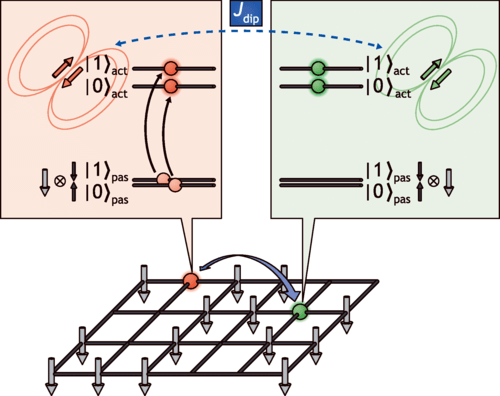A team of researchers at the Niels Bohr Institute, University of Copenhagen, have succeeded in entangling two very different quantum objects.
Researchers succeeded in making entanglement between a mechanical oscillator—a vibrating dielectric membrane—and a cloud of atoms, each acting as a tiny magnet, or what physicists call “spin.” These very different entities were possible to entangle by connecting them with photons, particles of light. Atoms can be useful in processing quantum information and the membrane—or mechanical quantum systems in general—can be useful for storage of quantum information.
To understand entanglement, sticking to the example of spins entangled with a mechanical membrane, imagine the position of the vibrating membrane and the tilt of the total spin of all atoms, akin to a spinning top. If both objects move randomly, but if observed moving right or left at the same time, that is called a correlation. Such correlated motion is normally limited to the so-called zero-point motion—the residual, uncorrelated motion of all matter that occurs even at absolute zero temperature. This limits knowledge about any of the systems.
A specific example of perspectives of entangling different quantum objects is quantum sensing. Different objects possess sensitivity to different external forces. For example, mechanical oscillators are used as accelerometers and force sensors, whereas atomic spins are used in magnetometers. When only one of the two different entangled objects is subject to external perturbation, entanglement allows it to be measured with a sensitivity not limited by the object’s zero-point fluctuations.
There is a fairly immediate possibility for application of the technique in sensing both for tiny oscillators and big ones. One of the biggest scientific pieces of news in recent years was the first detection of gravity waves, made by the Laser Interferometer Gravitational-wave Observatory (LIGO). LIGO senses and measures extremely faint waves caused by astronomical events in deep space, such as black hole mergers or neutron star mergers. The waves can be observed because they shake the mirrors of the interferometer. But even LIGO’s sensitivity is limited by quantum mechanics because the mirrors of the laser interferometer are also shaken by the zero-point fluctuations. Those fluctuations lead to noise preventing observation of the tiny motion of the mirrors caused by gravitational waves.
The result has therefore several potential applications in ultra-precise sensing and quantum communication. (Phys.org)
The study has been published in Nature Physics.



